How To Create A Scalable Guest Posting Strategy
-

Aaron Gray
- Blogs
-
 January 23 , 2023
January 23 , 2023 -
 13 min read
13 min read
Scalability in marketing is like a piece of rebar used in construction projects. It’s designed to be bendable by hand to accommodate a wide range of building designs or correct its shape and form when necessary. A “scalable” rebar makes a house or office building less likely to succumb to structural failure over time.
On the other hand, if a rebar isn’t capable of that, the entire project can stall. Every dollar paid for the wrong rebar goes to waste, forcing the contractor to spend extra on buying the right one. It gets worse if the contractor doesn’t have the money, putting the construction on hold for who knows how long—maybe indefinitely.

Now, picture that rebar as your marketing strategy. You can add as much resilience to it as you want, but you’d also want it to be flexible enough to respond to changes in the status quo. Make it too rigid, and it won’t be able to change no matter how much force is applied to it.
Companies value scalability in marketing strategies as much as the next element or fundamental. No one can say if today’s supply situation can keep up with the demand for goods and services tomorrow, not even with all the data in the world. Such strategies should still be implementable whether or not things go sour.
That also goes for how you deliver your content, specifically guest posts. Because guest posting requires a long time for its benefits to be noticeable enough, there may come a time when some parts, if not the whole strategy, become unviable or require updating. Some people thought they could still get away with keyword stuffing when Penguin practically banned the practice.
This blog post will discuss how to create a guest posting strategy. While no marketing strategy lasts forever, it’s possible to make it last several years amidst major market changes.
The six stages
If you need a refresher on guest posting, check out this blog post from 2018. It’s four years old, but most of the information, including guest posting tips, still applies.
According to Jeff Bullas, a famous influencer among Chief Marketing Officers, a typical guest posting strategy consists of six stages.

This is how scalability applies to each stage:
Stage 1: Planning
For the first stage, Bullas states that a project plan must contain three key details: a set of goals, the timeline to achieve them, and targets to achieve. The information presented here determines the details of the rest of the stages. Therefore, it’s logical that the planning stage gets the most attention in creating a scalable strategy.

As much as you want nothing less than to see your business succeed, listing too many goals from the start isn’t the ideal way to do it. In one survey, people using to-do lists only managed to check off 59% of all tasks—more than half but not really impressive numbers.
Timeline is another matter. Businesses almost always deal with multiple projects at a given time. The lack of a reasonable timeframe might lead businesses to put the project on the back burner for, as Bullas states, “a later date that will never come.”
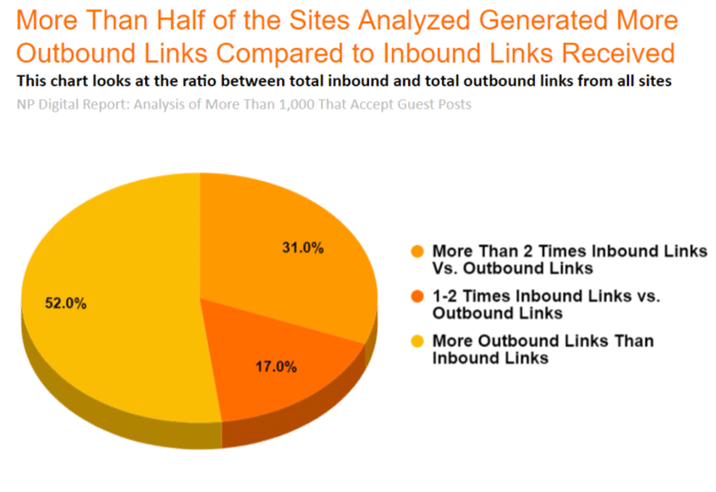
Targets need to be just as reasonable. It’s difficult enough to churn out dozens of guest posts per week or month without suffering from quality issues and, worse, attracting Google’s attention. On that note, guest posting is, as far as link building goes, a hit-and-miss; some articles will link aplenty while others won’t.
In an article in Harvard Business Review, bestselling business author and speaker Dorie Clark advises aligning goals with the business’ strategic vision. For executives and business leaders, she suggests looking back at strategies already in place. If a multi-year strategy aims to increase sales within the next two years, the goals should help realise that.
Clark also suggests determining a keystone goal, a goal in which reaching it will make reaching the other goals a lot easier. It usually involves performing a single task consistently. In this case, regularly writing quality guest posts can get a business leader closer to becoming a thought leader in the industry, leading to increased brand exposure.
Stage 2: Prospecting
The next step is looking for publisher sites willing to showcase your written content. You might think it shouldn’t be too hard; simply choose sites with high Domain Authority (DA). They get traffic by the millions daily, a testament to their trustworthiness.
But do you know which sites these are? Here are some examples and their DA scores from Moz.
- NIH.gov (95)
- WHO.int (95)
- Time.com (94)
- NewYorker.com (93)
- LATimes.com (93)
Some of these don’t accept guest posts yet those that do tend to have a strict screening process and a prohibitively long publishing queue. They also collectively receive pitches and entries by the hundreds, if not thousands, because other companies have the same idea of promoting their products and services.
In other words, you can still try to get these sites to publish your piece. But you’ll be lucky even to get a response from them—and that’s no guarantee of success. Focusing only on these sites is less likely to get any guest posting strategy moving.
Most experts agree that a DA score of 30 is an acceptable minimum in searching for prospective publishers. Niche sites and some local news sites comprise the majority of sites with such scores. Although they don’t get as much traffic as the high-DA ones, they get far fewer pitches, so there’s far less competition for brand visibility.
Businesses can still get away with guest posting on sites with DA scores of as low as 20, even as some experts warn that a DA score of 25 or below is a red flag. Moz, which created the DA metric and its conditions, stated that it’s better used as a tool for comparing DA scores of competitor sites within a search engine results page (SERPs) than as an indicator of quality and reputation.
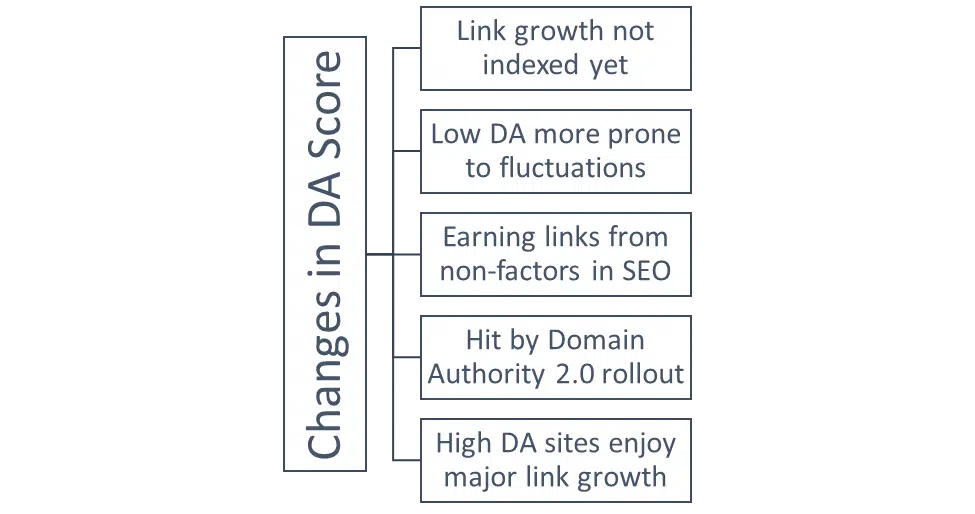
As a rule of thumb, consider prospective publishers with a higher DA score than your site. It’s easier to improve lower DA scores than higher ones because the site isn’t up against giants and household names.
Stage 3: Outreach
Bullas estimates that the response rate extremes for email outreach are 1.7% and 29%. Typically, the rate is between 7% and 9%, so a hundred emails sent out might produce less than 10 responses, emphasis on “responses” because a refusal on the publisher’s part is considered one. At best, your pitches may only qualify for roughly 10 publishers for every hundred prospects.
These numbers are discouraging but realistic. Even in low-traffic ones, publisher sites get tons of emails and have to comb their inboxes for content that’ll improve their standings on the internet. A poorly-written email will only get glossed over, much so if it ends up in their spam folder.
Given the extensive use of email templates and merge tags, you’re expected to send out plenty of these. To make this process more scalable, it pays to read a few pieces on the publisher’s website and look for patterns, such as:
- The target audience’s comprehension level (beginner to advanced)
- The target audience’s nature (consumers or fellow businesses)
- The preferred content format (tutorials, listicles, thorough analyses, etc.)
Of course, the most important aspect of a guest posting outreach is the pitch—the proposed idea for a guest post. The good news is that it’s hard to run out of unique things to write about, mainly because of keyword research. Many marketers swear by Answer the Public, a keyword research tool that generates content ideas based on keywords (preferably short-tail ones).
As an example, when you run the query “guest posting” on the tool, this is what you get.
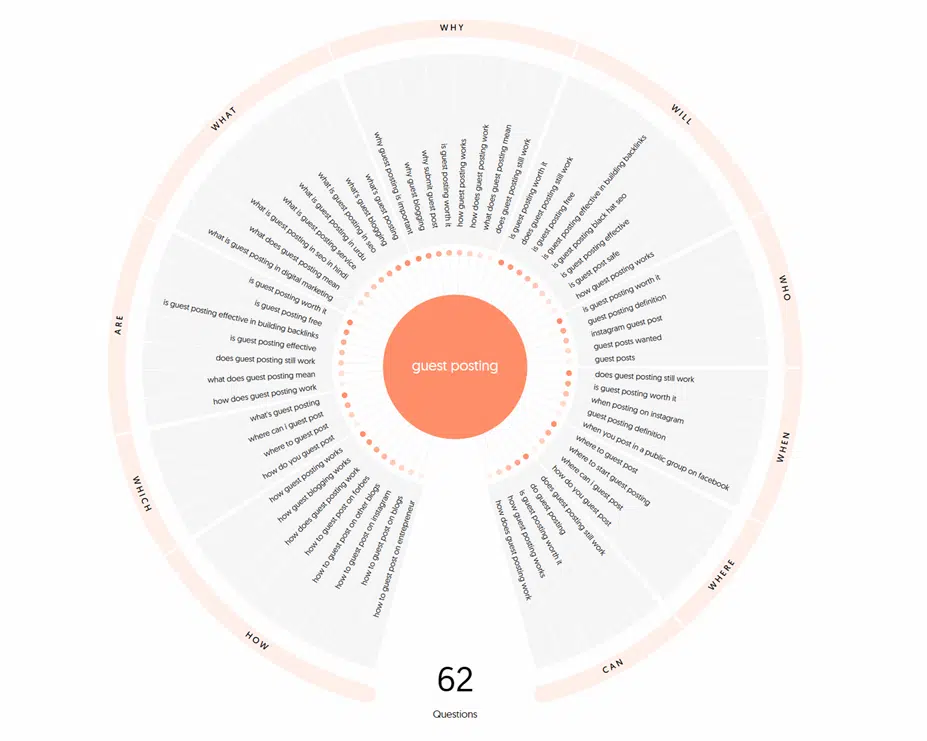
Not all of these suggestions are gems, as in the case of “do guest posting.” However, it gives you an idea of what people searching for a specific keyword would likely read. For instance, “is guest posting black hat seo” is worth more than a simple yes or no.
Another excellent tool is Ahrefs Content Explorer, integrated into its flagship analytics tool. It steps up keyword research by providing relevant data for each page, such as page traffic and the number of referring domains.
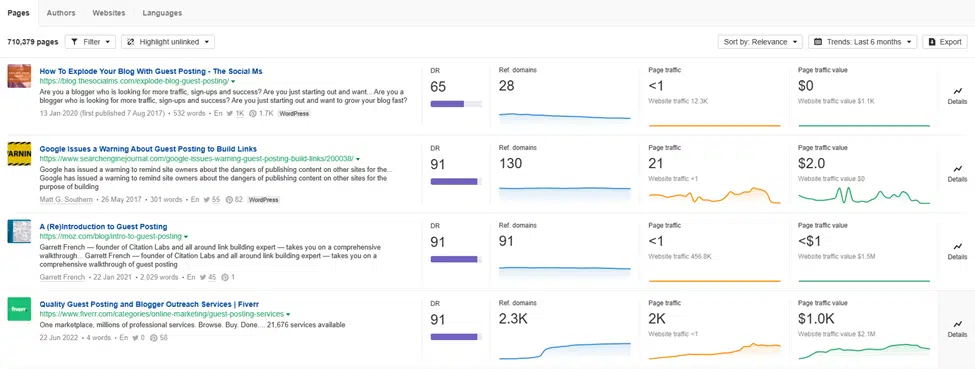
These tools are effective because the data changes in real time. As long as you’re up-to-date with the search data (and current affairs), there’s no need to worry about outdated guest posting ideas. Changes to topic ideas can be made before progressing further.
Stage 4: Scheduling
At this point, you should’ve received the green light from the publishers. Producing articles for multiple publisher sites warrant being organised, and producing quality articles takes days on top of running your business.
An editorial calendar makes the inherent chaos of content marketing manageable by tracking the progress and setting upload schedules, among other things. There’s an entire market for editorial calendar tools on the internet, but a custom-made one using Google Sheets or Excel also works. Below is a free template from Medium blog.

Editorial calendars are the epitome of scalability because it lets users configure and modify each data point. Posting on this platform? Just add another column. Not posting on that platform? Just delete it. Need to shuffle ideas around because something significant just happened? Change the entries as you see fit.
An editorial calendar that strictly focuses on guest posting can be as simple as a monthly planner. Experts recommend conducting a content audit at least once a year to ensure a content strategy’s effectiveness moving forward. In a study by the Content Marketing Institute in 2018, four out of five content pieces can end up unused because of factual discrepancies or changing priorities.
Stage 5: Publication
At this stage, the post is done and ready to be sent for publication. Once sent, there isn’t much to do other than wait for the post to go live or, if any, for one of the site’s staff to get back to you to request revisions, as it’s their site, their rules.
Take this time to get started on a new guest post if the editorial calendar says so. Perhaps return to the publisher’s site to review its submission guidelines again. If you feel your last post may not have been faithful to the guidelines and the publisher hasn’t responded, try again with a new post. Avoid writing it as a follow-up to the last submission.
But if you’re confident that the post has followed the guidelines to a T, experts advise waiting at least two to three weeks. Remember that behind a publishing site is a team of humans trying its best to sort through jam-packed inboxes. Sending follow-up emails too soon is a great way to get on the bad side (and not get the post published).
Experts also agree that two is the ideal maximum number of follow-up attempts. Consider the post moot if the publisher hasn’t responded after the second one. They have their reasons, so all you can do is respect their decision and move on.

Stage 6: Promotion
If the post goes live, then congratulations! It just bested hundreds of submissions and is ready for its time in the limelight. Because most viable publishing sites don’t get a ton of traffic, it falls on this final step to direct more readers to the post—and timeliness is the key.
Everything about ensuring timeliness in guest posts culminates here. An article about the best sneakers under USD$100 will benefit from a sudden rise in search interest for sneakers under USD$100. It’s impossible to predict such trends with 100% certainty, but there’ll always be at least someone looking for sneakers under USD$100.
Successful guest posters have plenty of options to spread the word about their content, the most popular being social media because of its huge user base. However, employing more than one option is better at maximising a guest post’s reach.
Some business sites have a dedicated page for all published off-site content, akin to a press page but for guest posts.
Guest posts can be promoted through forums and discussion platforms like Reddit and Quora. The latter is especially useful for business-to-business (B2B) companies because people from various walks of life frequent the site for answers, including experts. According to Hubspot, most Quora users have at least a college degree and a Herfindahl-Hirschman Index (HHI) that exceeds USD$100,000, more than some sites like LinkedIn and the Huffington Post.
Quora is also a great place to employ what business author Jim Collins calls the Flywheel Effect. He likened promotion efforts to a “5,000-lb flywheel,” which is hard to get it turning at the start but will eventually gain momentum the longer you push it. It’s for this reason that maintaining consistency is crucial.
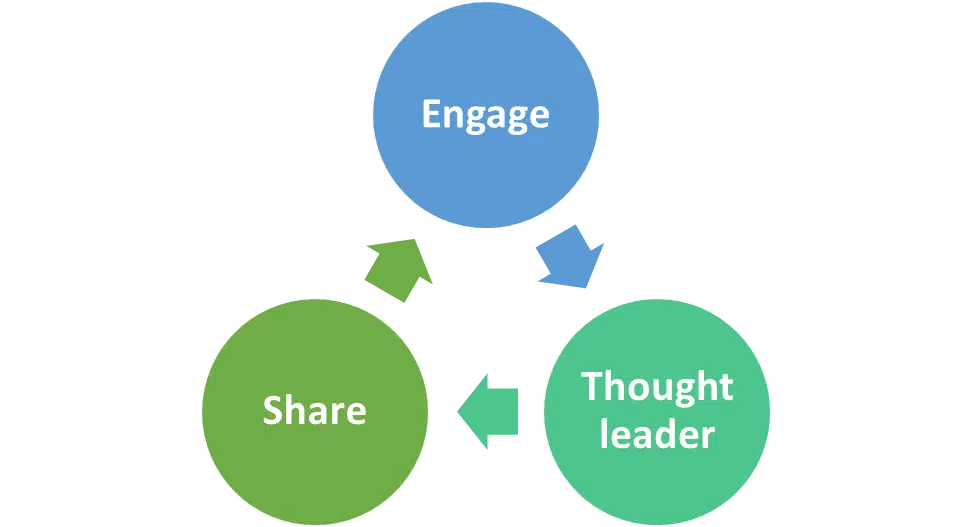
Don’t forget to send an email thanking the site for publishing your piece. It may seem simple and uneventful, but it can go a long way in establishing a working relationship with the publisher for future guest posting opportunities.
Repeat the process for the next guest post. Write a better post than the one you got published.
Build relationships, not links
Scalability in this context means a strategy that can be adjusted on the fly in case recent developments make prior information moot. Make a strategy that can bend like rebar when needed.
However, here’s one last example of a successful guest post. It’s written by Scott Kivowitz, a photographer who’s also a member of Moz’s SEO community. He got his piece published on the Moz blog in October 2012.
The title is: “Build Relationships, Not Links.”
It had only been several months since the Penguin update, but the piece largely painted a picture of the present. Link building has leaned more on relationship building than actual link building. Spamming content with links, regardless of quality, is now frowned upon. Because of this, guest posts are far less effective in improving rankings than they were before Penguin.
Yet businesses continue churning out guest posts because they find these effective in connecting with people. The piece generated a healthy discussion among fellow community members, most of whom agree with Kivowitz’s insights.
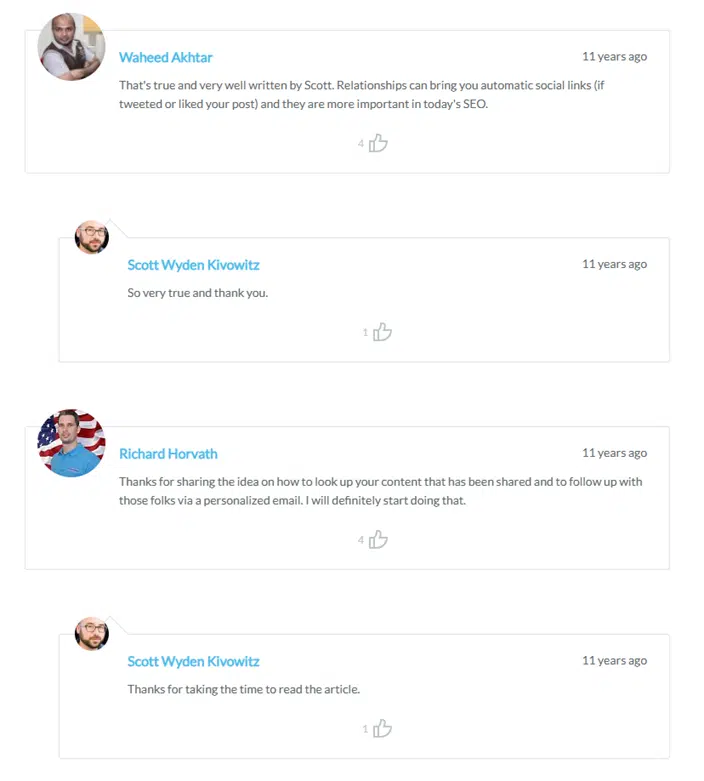
The takeaway is this: If you’re guest blogging for links, don’t.
Guest posting (and modern SEO, basically) should benefit the user, not the search engine. It’s a modern business’ obligation to provide information that a customer, potential or existing, seeks. Backlinks and other related benefits come as a nice bonus. While a slow path to success, people wouldn’t have it any other way.
You might wonder if there’s a way to achieve SEO success without relying on guest posting. Well, you’re in luck. Check out this post on alternative ways of getting quality backlinks.
Subscribe to Our Blog
Stay up to date with the latest marketing, sales, service tips and news.
Sign Up
"*" indicates required fields


